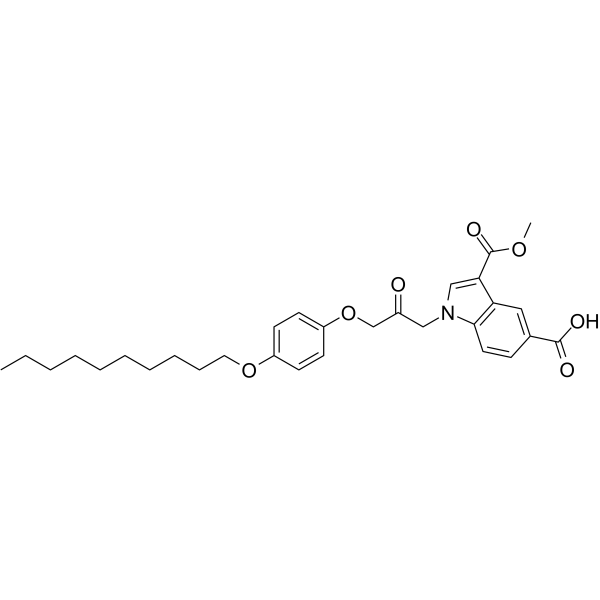| Description |
CAY10502 is a potent, calcium-dependent cytosolic phospholipase A2 α (cPLA2α) inhibitor with an IC50 of 4.3 nM for isolated enzyme. CAY10502 can be used in the research of retinopathy and inflammatory diseases[1][2][3].
|
| Related Catalog |
|
| Target |
cPLA2α:4.3 nM (IC50)
|
| In Vitro |
CAY10502 inhibits the release of arachidonic acid mediated by cPLA2R stimulanted with A23187 and TPA in human platelets, with IC50s of 0.57 and 0.0009 μM, respectively[1]. CAY10502 (5, 20, 50 nM; 12 hours; müller cells) inhibits normoxic- and hypoxia-induced Prostaglandin E2 (PGE2) and VEGF production[2]. CAY10502 (0.1-100 nM; 24 hours) inhibits the VEGF-induced proliferation of rat retinal microvascular endothelial cells (RRMEC)[2]. CAY10502 (10 μM) inhibits arachidonic acid (AA) release from the phospholipid pools, abrogated extremely low-frequency electromagnetic fields (ELF-EMF; 1 h) induced AA increase and the ELF-EMF inhibitory effect of Cav3.2 channels[3]. Cell Proliferation Assay[2] Cell Line: RRMEC Concentration: 0.1-100 nM Incubation Time: 24 hours Result: CAY10502 (35, 50 nM) demonstrated significant reductions in VEGF-induced proliferation (64.3% and 84.1%, respectively) compared with cultures treated with VEGF alone.
|
| In Vivo |
CAY10502-injected (2.5, 25, 100 nM; 5 μL) eyes demonstrates a dose-dependent inhibition of retinal neovascularization (NV) in rat oxygen-induced retinopathy (OIR)[2]. Animal Model: OIR and room air (RA) Sprague-Dawley rat[2] Dosage: 2.5, 25, 100 nM; 5 μL Administration: Intravitreal Injection Result: Injection of 100 nM CAY10502 resulted in a 53.1% reduction in NV compared with vehicle treatment.
|
| References |
[1]. Pohjala L L, et al. Interference by bovine serum albumin in PED6 based phospholipase A2 screening assays[J]. Die Pharmazie, 2012. [2]. Barnett JM, et al. Role of cytosolic phospholipase A(2) in retinal neovascularization. Invest Ophthalmol Vis Sci. 2010;51(2):1136-1142. [3]. Cui Y, et al. Exposure to extremely low-frequency electromagnetic fields inhibits T-type calcium channels via AA/LTE4 signaling pathway. Cell Calcium. 2014 Jan;55(1):48-58.
|
